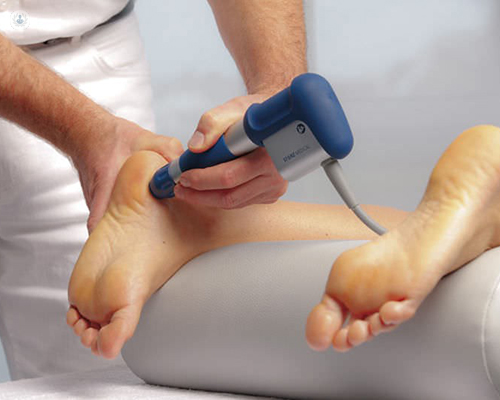Shockwave therapy - How is it used to treat heel pain?
Escrito por:Shockwave treatment is a very useful therapy in the management of stubborn cases of heel pain. It is most commonly used as a treatment for pain related to the tendons, often in the foot and ankle, though shockwave therapy can be used to treat a wide range of orthopaedic conditions.
Shockwave therapy is a non-surgical therapy. It has been shown to speed up recovery from many injuries, and is effective as a cure for chronic pain. Leading orthopaedic surgeon, Mr Matthew Solan discusses the treatment.

When is shockwave therapy used?
Shockwave therapy is used in conditions of long-lasting pain (chronic pain), such as plantar fasciitis and Achilles tendon problems. These are conditions where healing may be very slow, leading to frustration if the pain has been lingering for a long time.
Shockwave therapy is not advisable when the symptoms have only been present for a short time, as the treatment works by stimulating inflammation within the body. If the injury is fresh, then ordinary inflammation is still present. Using shockwave in these circumstances may make the injury worse.
How does shockwave therapy work?
It is not fully understood how shockwave treatment works. Two mechanisms are thought to contribute: firstly, shockwaves act as a pain relieving treatment through their action on small nerve endings that are oversensitive; secondly, the shockwaves stimulate fresh healing within the injured area.
In essence, shockwaves can be considered as a means of deliberately causing physical micro-injury to a specific area. This micro-injury rekindles the body’s healing processes and gives another chance for the body to heal. During the settling down stage, it is important that the patient continues with the stretching exercises that will have been recommended by the physiotherapist, since this optimises the chances of a successful result.
Does shockwave therapy hurt?
Yes, it is usually described as uncomfortable or painful – but it is manageable, since each session of treatment only lasts around five minutes. There is evidence that numbing the area with local anesthesia before treatment leads to much lower success rates, so this (attractive idea) is not recommended. There are very other few side-effects to consider, making Shockwave a popular and effective treatment in cases of stubborn heel pain
If you would like to book an appointment for shock wave therapy with a specialist, you can do so by clicking this link.


